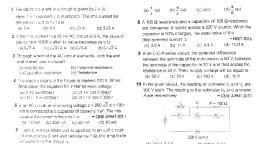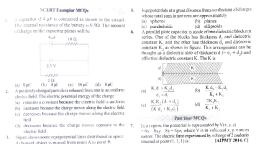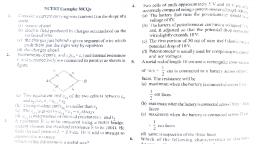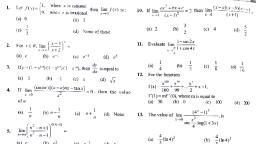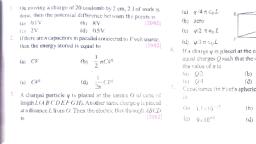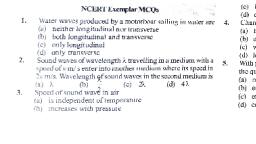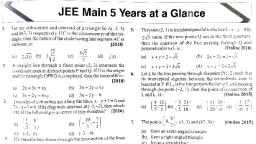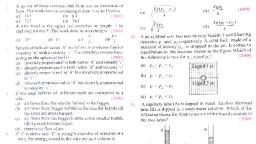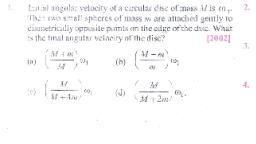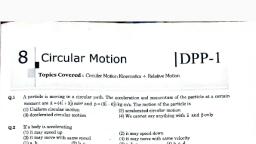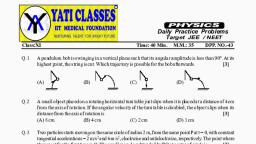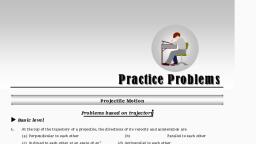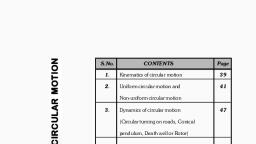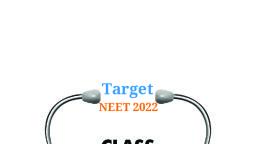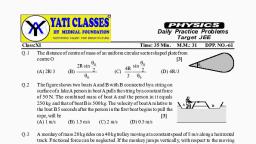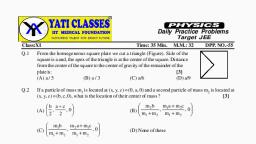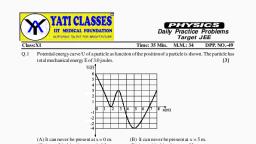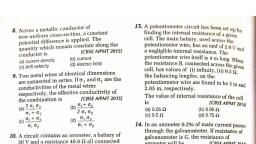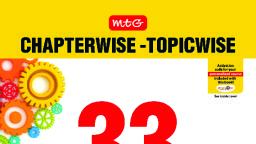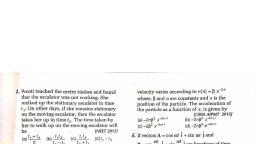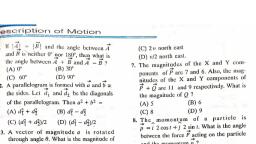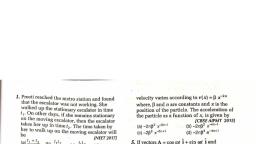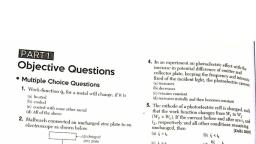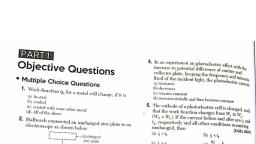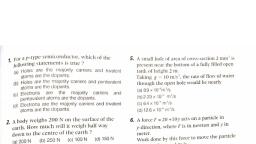Page 1 :
PHYSICS, , Daily Practice Problems, , Target JEE / NEET, Discussion: 20-21/07/2015 Time: 40 Min. M.M.: 35, DPP. NO.-43, , Class:XI, Q.1, , A pendulum bob is swinging in a vertical plane such that its angular amplitude is less than 90°. At its, highest point, the string is cut. Which trajectory is possible for the bob afterwards., [3], (A), , (B), , (C), , (D), , Q.2, , A small object placed on a rotating horizontal turn table just slips when it is placed at a distance of 4 cm, from the axis of rotation. If the angular velocity of the turn table is doubled, the object slips when its, distance from the axis of rotation is, [3], (A) 8 cm, (B) 4 cm, (C) 2 cm, (D) 1 cm, , Q.3, , Two particles starts moving on the same circle of radius 2 m, from the same point P at t = 0, with constant, tangential accelerations = 2 m/s2 and 6 m/s2, clockwise and anticlockwise, respectively. The point where, they meet for the first time is Q. The smaller angle subtended by PQ at center of circle is, [3], (A) 120°, (B) 60°, (C) 135°, (D) 90°, , Q.4, , Two particles of equal mass are attached to a string of length 2m as shown in figure. The string and, particles are then whirled in a horizontal circle about O. The ratio of the tension in string between P and, Q to and tension in the string between P and O is, [3], (A), , Q.5, , 1, 2, , 2, 3, , (C), , 3, 2, , (D) 2, , Aparticle of mass m is fixed to one end of a light spring of force constant k and unstretched length ., The system is rotated about the other end of the spring with an angular velocity in gravity free space., The increase in length of the spring is, [3], , m 2 , (A), k, Q.6, , (B), , m 2 , (B), k m 2, , m 2 , (C), k m 2, , (D) none of these, , Two different masses (M1=0.25 kg and M2=1.0 kg) are connected to two, strings as shown in thefigure. Both masses rotate inhorizontal smooth plane, about a central fixed point with a frequency 10 rad/sec in circles of radius, R1=5cm and R2=10cm respectively.The ratio of tensionT1/T2 in the string is, [3], (A) 11/9, (B) 9/8, (C) 8/9, (D) 9/11, , PAGE # 1
Page 2 :
Q.7, , At the same instant two boys throw balls A and B from the positions shown with a speed v0 and kv0, respectively, where k is a constant. For what value of k, balls will collide ? Relevant data are available in, figure., [3], , A, , h, , B, , cos 2, (A) cos , 1, , Q.8, , Q.9, , , , v0, Point of, collision, , kv0, , , d, , sin 2, (B) cos , 1, , tan 2, (C) tan , 1, , cot 2, (D) cot , 1, , AB is horizontal diameter of a vertical circle. If time taken by a particle to slide along chordAC be t1 and, that corresponding to chord BC be t2, then, [4], t2, , (A) t1 = t2, , (B), , (C) t1 × t2 = constant {independent of }, , (D) none of these, , t1, , = tan, , A heavy particle is tied to the end Aof a string of length 1.6 m. Its other end O is fixed. It revolves as a, conical pendulum with the string making 60o with the vertical. Then, [4], 4, sec., 7, (B) the tension in the string is doubled the weight of the particle, , (A) its period of revolution is, , (C) the velocity of the particle = 2.8 3 m/s, (D) the centripetal acceleration of the particle is 9.83 m/s2., Q.10, , Ariver is flowing with speed 3 km/hr west to east.Aman swims with speed 5km/hr in still water. Man is, at south bank of the river. Match the column-I with direction of velocities of man w.r.t. ground in, column-II., [6], Column-I, Column-II, (A), , Man swims at an angle 127° from river flow., , (P), , (B), , Man swims right angle to river flow, , (Q), , (C), , Man swims at an angle 143° from river flow., , (R), (S), , PAGE # 2
Page 3 :
PHYSICS, , Daily Practice Problems, , Class:XI (P), Q.1, , Target JEE /NEET, Discussion: 22-23/07/2015 Time: 45 Min. M.M.: 42, DPP. NO.-44, , A particle of mass m is moving in a circular path of constant radius r such that its centripetal acceleration, ac is varying with time t as ac = k2rt2 where k is a constant. The power delivered to the particle by the, forces acting on it is given by, [3], (A) 2mk2r2t, , (B) mk2r2t, , (C), , (mk 4 r 2 t 5 ), 3, , (D) zero, , Q.2, , In anAfrican wildlife reserve your jeep is travelling at a constant speed of 105 km/hr alongside a cheetah, running at constant speed. The animal, frightened by the jeep's noise, keeps at a constant distance of 60, m from the vehicle. Not having paid much attention to the surrounding landscape, you suddenly realize, that your jeep is passing the very same spot where it was 60 seconds before. The speed of the cheetah, is, [3], (A) 105 km/hr, (B) 94 km/hr, (C) 99 km/hr, (D) 82 km/hr, , Q.3, , Which of the following statement(s) is/are true for a particle moving in a circle with a constant angular, acceleration?, [3], (A) The magnitude of acceleration is constant., (B) The acceleration vector is along the tangent to the circle., (C) The velocity vector points along tangent to the circle., (D) The velocity and acceleration vectors are always perpendicular to each other., , Q.4, , A body on earth's surface is at a latitude of 60°N. Consider only rotation of earth about its own axis then, (Take : Earth's radius = 6400 km), [3], 2, (A) Centripetal acceleration of body is 0.017 m/s, (B) Centripetal acceleration of body is 0.034 m/s2, (C) Centripetal acceleration of body is 1 m/s2, (D) Centripetal acceleration of body is 9.8 m/s2, , Q.5, , Consider a shell that has a muzzle velocity of 45 ms–1 fired from the tail gun of an airplane moving, horizontally with a velocity of 215 ms–1. The tail gun can be directed at any angle with the vertical in the, plane of motion of the airplane. The shell is fired when the plane is above point A on ground, and the, plane is above point B on ground when the shell hits the ground. (Assume for simplicity that the Earth is, flat), [4], (A) Shell may hit the ground at point A., (B) Shell may hit the ground at point B., (C) Shell may hit a point on earth which is behind point A., (D) Shell may hit a point on earth which is ahead of point B., , Q.6, , Aparticle P of mass m is attached to a vertical axis by two stringsAP and BP of, length l each. The separation AB=l. P rotates around the axis with an angular, velocity . The tensions in the two strings are T1 and T2, [4], 2, (A) T1=T2, (B) T1+T2=m l, (C) T1-T2=2mg, , (D) BP will remain taut only if , , 2g, , PAGE # 3
Page 4 :
Q.7, , Q.8, , y, , A particle is moving in uniform circular motion in x-yplane, with radius, 1m and centre as origin. At t = 0, the particle is (R, 0) as shown. Time, period of the path is 4 seconds. Match the quantities the of column-I, with possible instant of time(s) of column-II., [6], , v, O, , Column-I, , Column-II, , (A), , Direction of average acceleration is, , (P), , till t = 1 sec., , (B), , Direction of average velocity is, , (Q), , till t = 3 sec., , (C), , Distance travelled by the particle is, , (R), , till t = 5 sec., , (D), , Magnitude of displacement of the particle is R 2, , (S), (T), , till t = 7 sec., till t = 9 sec., , R, 2, , Match the column to value of Tension assuming mass of particle equal to m :, Column-I, Column-II, , 53°, , (A), , T, , (P), , 4mg, 5, , (Q), , 5mg, 4, , (R), , 3mg, 5, , (S), , 5mg, 3, , (R,0), , x, , [6], , Extreme position in simple pendulum, , (B), , 37°, T, , Conical pendulum, 53°, , (C), , a, , T, , Cart is accelerated such that particle, remains at rest as shown w.r.t. cart., T, , (D), , a = g sin 37°, 37°, , Cart is accelerating freely on the incline. Particle, remains at rest w.r.t. cart as shown., Q.9, , A projectile, 1 sec after itsprojection is found to make an angle of 45° with the horizontal.A fter another, onesecond it istravelling horizontally. Find themagnitudeof itsinitial velocity and angleof projection.[5], , Q.10, , A parachutist after bailing out falls 52 m without friction . When the parachute opens, she decelerates at, 2.1 ms1 & reaches the ground with a speed of 2.9 ms1 ., [5], how long has been the parachutist in the air ?, at what height did the fall begin ?, , (i), (ii), , PAGE # 4
Page 5 :
PHYSICS, , Daily Practice Problems, , Target JEE/NEET, Discussion: 24-25/07/2015 Time: 35 Min. M.M.: 30, DPP. NO.-45, , Class:XI (P), Q.1, , A jet traveling at a constant speed of 1.20 × 102 m/s executes a vertical loop with a radius of 5.00×102, m. (See Fig.) Find the magnitude of the force of the seat on a 70.0-kg pilot at the top of the loop. (Take, , g = 10 m/s2), [3], v, R, , , v, , (A) 1316 N, Q.2, , (C) 700 N, , (D) 2000N, , A circular curve of a highway is designed for traffic moving at 72 km/h. If the radius of the curved path, is 100m, the correct angle of banking of the road should be given by, [3], 1, (A) tan, , Q.3, , (B) 2700 N, , 2, 5, , 1, (B) tan, , 3, 5, , 1, (C) tan, , 1, 5, , 1, (D) tan, , A car is travelling on a banked road with a speed of 10m/s on a banked road of inclination 37º in a circle, of radius 30 m. The car does not skid. The correct Free body diagram of car is, [3], N, , N, , N, f, , (A), , (B), f, , Q.4, , 37° mg, , (C), , (D) f, , 37° mg, , 37° mg, , 37° mg, , A small particle is placed on top of a fixed hemisphere. Particle is projected with a speed v = 2gR ., What is the radius of curvature of the path of the particle at the given instant, [3], , (A) 2R, , Q.6, , N, f, , v, , Q.5, , 1, 4, , (B) R, , 2 gR, , (C), , R, 2, , (D) 4R, , , , A force F = (3t î 5ˆj) N acts on a body due to which its displacement varies as s ( 2 t 2 î 5ˆj) . Work, ork, done by this force in t = 0 to 2 sec is:, [3], (A) 23 J, (B) 32 J, (C) zero, (D) can’t be obtained., , A spring of force constant k is cut in two part at its one third length. when both the parts are stretched by, same amount. The work done in the two parts, will be, [3], (A) equal in both, (B) greater for the longer part, (C) greater for the shorter part, (D) data insufficient., PAGE # 5
Page 6 :
Q.7, , , A particle is moved from (0, 0) to (a, a) under a force F (3î 4ˆj) from two, paths. Path 1 is OP and path 2 is OQP. Let W1 and W2 be the work done by this, force in these two paths. Then, [3], (A) W1 = W2, (B) W1 = 2W2, (C) W2 = 2W1, (D) W2 = 4W1, , Paragraph for question nos. 8 to 10, An athelete of mass 80 kg is running on a rough track whose cross-section is shown below. The, lower part AB of track is a cylindrical valley of radius 100 m and upper part BC is a cylindrical hill of, radius 200 m. The two parts join such that there is no sudden change of slope of the track. The speed, of the athelete on the track is always 5m/s.Ais the lowest point of the valley, B is the point at which, valley ends and hill starts and C is the top of the hill. While moving fromAto C, the athelete travels a, horizontal distance of 150 m., C, , B, A, , Q.8, Q.9, Q.10, , Find the time taken by the athelete in going fromAto C, (A) 5 sec, (B) 10 sec, (C) 15 sec, The correct order of normal force experienced by athelete is :, (A) NA > NB > NC, (B) NA < NB < NC, (C) NA > NC > NB, , [3], (D) 20 sec, [3], (D) NC > NA > NB, , The magnitude of friction force experienced by the athelete is :, [3], (A) zero throughout, (B) decreases continuously during motion fromAto C, (C) increases continuously fromAto C (D) attains a maximum value at B, , PAGE # 6

